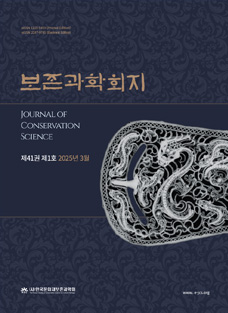Journal of Conservation Science Vol.28 No.4 pp.403-410
한국의 방짜유기에 가해지는 염수처리의 효과에 관한 연구
Effect of Brine Treatment Applied in the Manufacture of Traditional Forged High Tin Bronzes of Korea
Jae-Sung Lee,Ik-Hwan Jeon,Seok-chul Kwak,Jang-Sik Park
Abstract
The brine treatment applied during the fabrication of forged high tin bronze objects is considered effective at the removal of surface oxide layers developed at elevated temperatures. There is not much information, however, available for the understanding of its exact effect and purpose. This work performed laboratory experiments to characterize the effect brine treatments produce on the surface of bronze objects during fabrication. Specimens were first made in the bronze shop of the Yongin folk village under varying conditions of brine treatments, and the results obtained were then used in the following laboratory experiments where the effect of brine treatments were investigated in terms of brine concentrations, alloy compositions and thermo-mechanical treatments. The results show that oxide layers generated at high temperature are easily removed by the brine treatment. It was found that the element, chlorine, played a key role in the removal of such oxide layers as opposed to the other constituent of the brine, sodium, makes no notable contribution. In bronze alloys containing 22% tin, this brine effect is obtained regardless of the application of forging as long as the brine concentration is over 0.5% based on weight. In alloys containing lead, however, no brine effect is observed due to the molten lead that emerges from inside the hot bronze specimen and forms a thin layer on its surface.

 E-Submission
E-Submission 
 E-Submission
E-Submission 
![]() Journal Search Engine
Journal Search Engine




 KSC
KSC